Fauna Control Strategies and Management: Theory Questions, Semester 1
VerifiedAdded on 2022/12/26
|13
|4249
|84
Homework Assignment
AI Summary
This assignment addresses a series of theory questions related to fauna population management, encompassing various aspects of wildlife control and conservation. The questions delve into the purpose of habitat survey assessments within pest management plans, exploring strategies for estimating species populations, and the importance of considering previous control methods and resident fauna. The assignment also examines the significance of legislative requirements in implementing control strategies, the role of stakeholders, and actions to take when legislative requirements are not met. Furthermore, it explores the legal aspects of fauna control on private and public lands, methods for evaluating the success of control programs, and the impact of public perception. Codes of practice, industry standards, and the purpose of habitat review and species movement assessment are also discussed. The importance of minimizing harm to wildlife, record-keeping, and the evaluation of control programs are also included, along with multiple-choice and true/false questions regarding baiting programs and professional pest management.
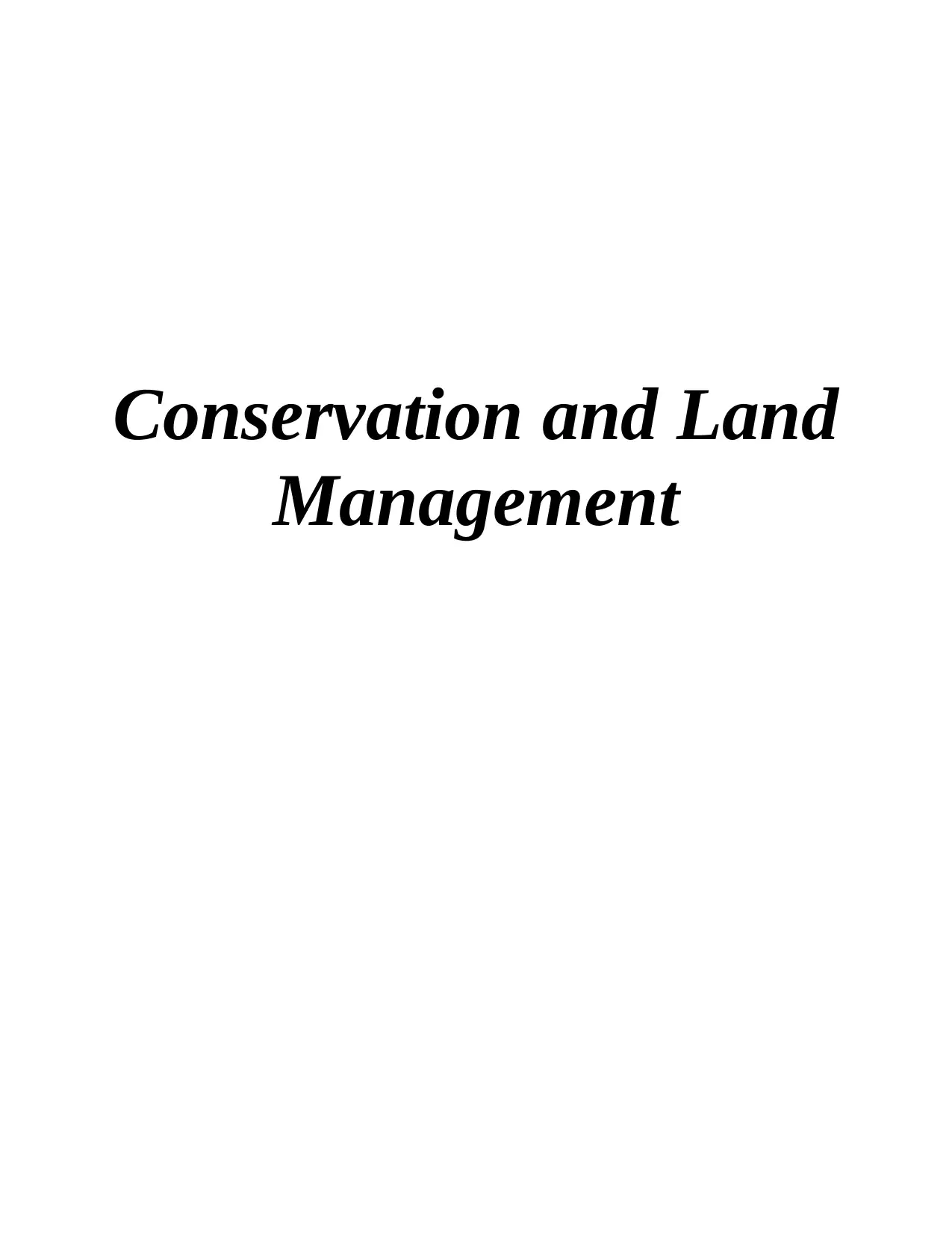
Conservation and Land
Management
Management
Paraphrase This Document
Need a fresh take? Get an instant paraphrase of this document with our AI Paraphraser
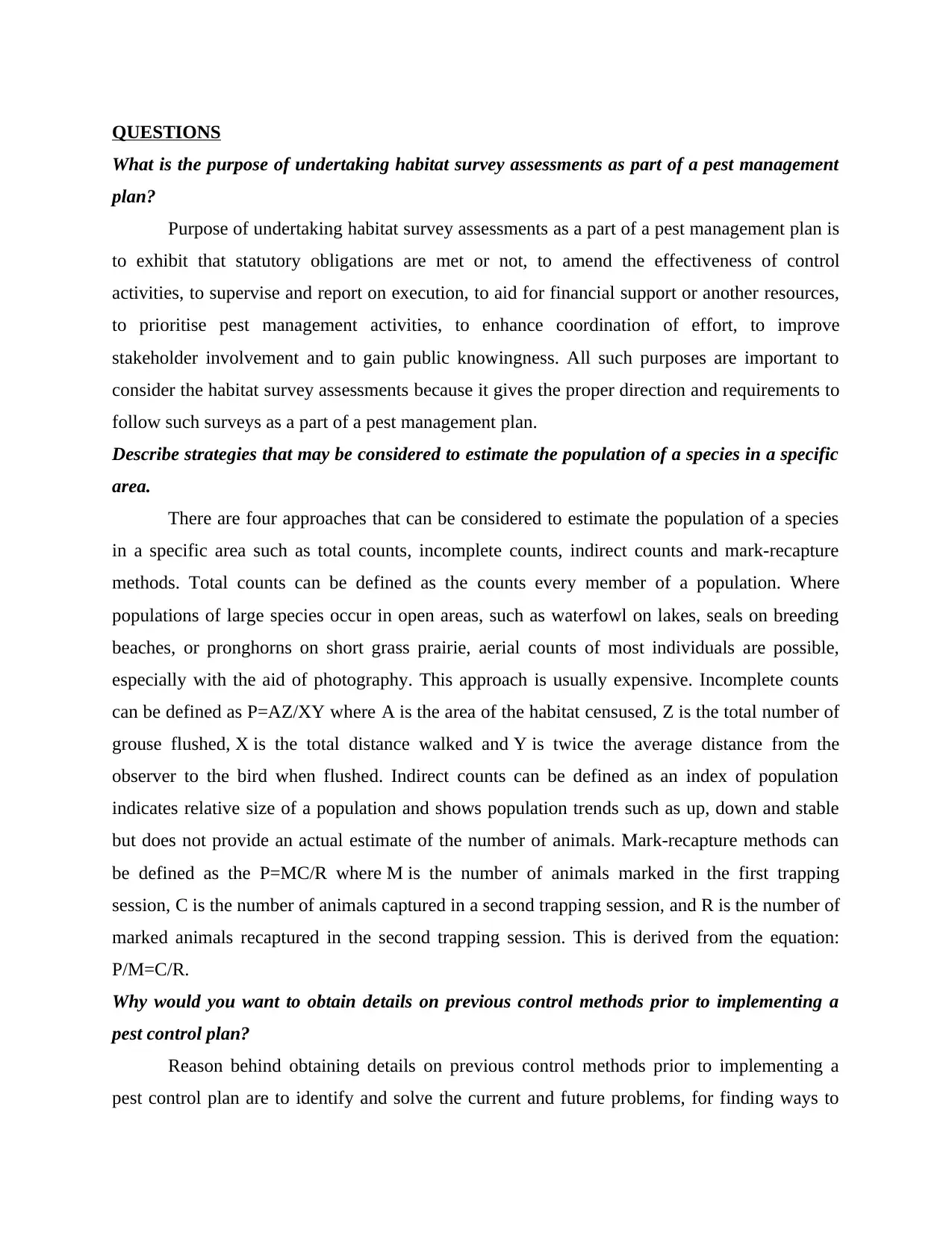
QUESTIONS
What is the purpose of undertaking habitat survey assessments as part of a pest management
plan?
Purpose of undertaking habitat survey assessments as a part of a pest management plan is
to exhibit that statutory obligations are met or not, to amend the effectiveness of control
activities, to supervise and report on execution, to aid for financial support or another resources,
to prioritise pest management activities, to enhance coordination of effort, to improve
stakeholder involvement and to gain public knowingness. All such purposes are important to
consider the habitat survey assessments because it gives the proper direction and requirements to
follow such surveys as a part of a pest management plan.
Describe strategies that may be considered to estimate the population of a species in a specific
area.
There are four approaches that can be considered to estimate the population of a species
in a specific area such as total counts, incomplete counts, indirect counts and mark-recapture
methods. Total counts can be defined as the counts every member of a population. Where
populations of large species occur in open areas, such as waterfowl on lakes, seals on breeding
beaches, or pronghorns on short grass prairie, aerial counts of most individuals are possible,
especially with the aid of photography. This approach is usually expensive. Incomplete counts
can be defined as P=AZ/XY where A is the area of the habitat censused, Z is the total number of
grouse flushed, X is the total distance walked and Y is twice the average distance from the
observer to the bird when flushed. Indirect counts can be defined as an index of population
indicates relative size of a population and shows population trends such as up, down and stable
but does not provide an actual estimate of the number of animals. Mark-recapture methods can
be defined as the P=MC/R where M is the number of animals marked in the first trapping
session, C is the number of animals captured in a second trapping session, and R is the number of
marked animals recaptured in the second trapping session. This is derived from the equation:
P/M=C/R.
Why would you want to obtain details on previous control methods prior to implementing a
pest control plan?
Reason behind obtaining details on previous control methods prior to implementing a
pest control plan are to identify and solve the current and future problems, for finding ways to
What is the purpose of undertaking habitat survey assessments as part of a pest management
plan?
Purpose of undertaking habitat survey assessments as a part of a pest management plan is
to exhibit that statutory obligations are met or not, to amend the effectiveness of control
activities, to supervise and report on execution, to aid for financial support or another resources,
to prioritise pest management activities, to enhance coordination of effort, to improve
stakeholder involvement and to gain public knowingness. All such purposes are important to
consider the habitat survey assessments because it gives the proper direction and requirements to
follow such surveys as a part of a pest management plan.
Describe strategies that may be considered to estimate the population of a species in a specific
area.
There are four approaches that can be considered to estimate the population of a species
in a specific area such as total counts, incomplete counts, indirect counts and mark-recapture
methods. Total counts can be defined as the counts every member of a population. Where
populations of large species occur in open areas, such as waterfowl on lakes, seals on breeding
beaches, or pronghorns on short grass prairie, aerial counts of most individuals are possible,
especially with the aid of photography. This approach is usually expensive. Incomplete counts
can be defined as P=AZ/XY where A is the area of the habitat censused, Z is the total number of
grouse flushed, X is the total distance walked and Y is twice the average distance from the
observer to the bird when flushed. Indirect counts can be defined as an index of population
indicates relative size of a population and shows population trends such as up, down and stable
but does not provide an actual estimate of the number of animals. Mark-recapture methods can
be defined as the P=MC/R where M is the number of animals marked in the first trapping
session, C is the number of animals captured in a second trapping session, and R is the number of
marked animals recaptured in the second trapping session. This is derived from the equation:
P/M=C/R.
Why would you want to obtain details on previous control methods prior to implementing a
pest control plan?
Reason behind obtaining details on previous control methods prior to implementing a
pest control plan are to identify and solve the current and future problems, for finding ways to

improve pest management plan, for determining the facility or event associated with the control
management, for measuring success or failure of previous control methods, to identify and
measure impacts on current situations, for satisfying sponsors and other stakeholders related with
the management and to gain acceptance, credibility and support. These are the major reasons for
which previous control methods details are required to be fetch out for an appropriate
implementation of a pest control plan.
What information do you need about the resident fauna populations prior to effecting control
strategies?
It is important to study and review the information about control strategies of resident
fauna populations such as prey control, lethal control and Live control. It is important to keep the
information of all such strategies in order to keep track of the fauna population. Analysing such
data and by processing this into an useful information can help the stakeholders to determine and
identify the effective information prior to the effecting control strategies.
Why is it important to review legislative requirements prior to implementing lethal control
strategies?
It is important to review legislative requirements prior to implementing lethal control
because it justifies the proper law that is required to be followed before implementing the
strategy as it defines the fauna population restrictions as well for the species so that any illegal
attempt cannot be raised out and that is why legislative requirements are essential for the
implementation.
What stakeholders could be relevant to the success of a fauna control strategy?
Stakeholders that can be relevant to the success of fauna control strategies are NGOs and
local communities, experts and scientist, public authorities and coalitions and industrial
associations. They contributes the fauna control strategies in a very great manner in order to
enhance the current and future conditions of the fauna population.
If a strategy engaged outside of your project did not meet legislative requirements, what
should you do?
Although it is important to meet the legislative requirements in establishment of the
strategies but due to some reasons it cannot be met then the organiser must recheck and evaluate
the whole program that is being conducted in order to meet maximum and whole legislative
management, for measuring success or failure of previous control methods, to identify and
measure impacts on current situations, for satisfying sponsors and other stakeholders related with
the management and to gain acceptance, credibility and support. These are the major reasons for
which previous control methods details are required to be fetch out for an appropriate
implementation of a pest control plan.
What information do you need about the resident fauna populations prior to effecting control
strategies?
It is important to study and review the information about control strategies of resident
fauna populations such as prey control, lethal control and Live control. It is important to keep the
information of all such strategies in order to keep track of the fauna population. Analysing such
data and by processing this into an useful information can help the stakeholders to determine and
identify the effective information prior to the effecting control strategies.
Why is it important to review legislative requirements prior to implementing lethal control
strategies?
It is important to review legislative requirements prior to implementing lethal control
because it justifies the proper law that is required to be followed before implementing the
strategy as it defines the fauna population restrictions as well for the species so that any illegal
attempt cannot be raised out and that is why legislative requirements are essential for the
implementation.
What stakeholders could be relevant to the success of a fauna control strategy?
Stakeholders that can be relevant to the success of fauna control strategies are NGOs and
local communities, experts and scientist, public authorities and coalitions and industrial
associations. They contributes the fauna control strategies in a very great manner in order to
enhance the current and future conditions of the fauna population.
If a strategy engaged outside of your project did not meet legislative requirements, what
should you do?
Although it is important to meet the legislative requirements in establishment of the
strategies but due to some reasons it cannot be met then the organiser must recheck and evaluate
the whole program that is being conducted in order to meet maximum and whole legislative
⊘ This is a preview!⊘
Do you want full access?
Subscribe today to unlock all pages.

Trusted by 1+ million students worldwide
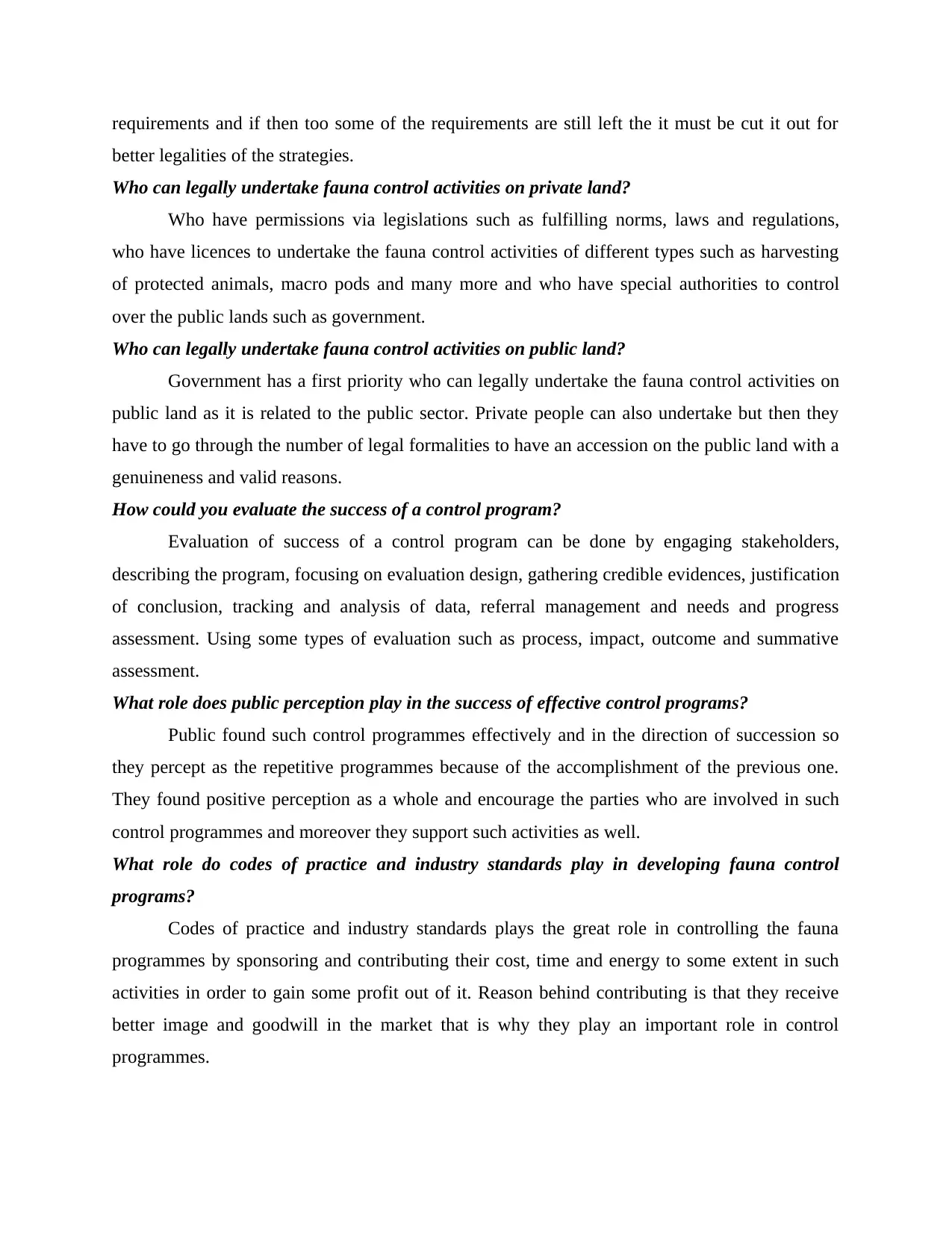
requirements and if then too some of the requirements are still left the it must be cut it out for
better legalities of the strategies.
Who can legally undertake fauna control activities on private land?
Who have permissions via legislations such as fulfilling norms, laws and regulations,
who have licences to undertake the fauna control activities of different types such as harvesting
of protected animals, macro pods and many more and who have special authorities to control
over the public lands such as government.
Who can legally undertake fauna control activities on public land?
Government has a first priority who can legally undertake the fauna control activities on
public land as it is related to the public sector. Private people can also undertake but then they
have to go through the number of legal formalities to have an accession on the public land with a
genuineness and valid reasons.
How could you evaluate the success of a control program?
Evaluation of success of a control program can be done by engaging stakeholders,
describing the program, focusing on evaluation design, gathering credible evidences, justification
of conclusion, tracking and analysis of data, referral management and needs and progress
assessment. Using some types of evaluation such as process, impact, outcome and summative
assessment.
What role does public perception play in the success of effective control programs?
Public found such control programmes effectively and in the direction of succession so
they percept as the repetitive programmes because of the accomplishment of the previous one.
They found positive perception as a whole and encourage the parties who are involved in such
control programmes and moreover they support such activities as well.
What role do codes of practice and industry standards play in developing fauna control
programs?
Codes of practice and industry standards plays the great role in controlling the fauna
programmes by sponsoring and contributing their cost, time and energy to some extent in such
activities in order to gain some profit out of it. Reason behind contributing is that they receive
better image and goodwill in the market that is why they play an important role in control
programmes.
better legalities of the strategies.
Who can legally undertake fauna control activities on private land?
Who have permissions via legislations such as fulfilling norms, laws and regulations,
who have licences to undertake the fauna control activities of different types such as harvesting
of protected animals, macro pods and many more and who have special authorities to control
over the public lands such as government.
Who can legally undertake fauna control activities on public land?
Government has a first priority who can legally undertake the fauna control activities on
public land as it is related to the public sector. Private people can also undertake but then they
have to go through the number of legal formalities to have an accession on the public land with a
genuineness and valid reasons.
How could you evaluate the success of a control program?
Evaluation of success of a control program can be done by engaging stakeholders,
describing the program, focusing on evaluation design, gathering credible evidences, justification
of conclusion, tracking and analysis of data, referral management and needs and progress
assessment. Using some types of evaluation such as process, impact, outcome and summative
assessment.
What role does public perception play in the success of effective control programs?
Public found such control programmes effectively and in the direction of succession so
they percept as the repetitive programmes because of the accomplishment of the previous one.
They found positive perception as a whole and encourage the parties who are involved in such
control programmes and moreover they support such activities as well.
What role do codes of practice and industry standards play in developing fauna control
programs?
Codes of practice and industry standards plays the great role in controlling the fauna
programmes by sponsoring and contributing their cost, time and energy to some extent in such
activities in order to gain some profit out of it. Reason behind contributing is that they receive
better image and goodwill in the market that is why they play an important role in control
programmes.
Paraphrase This Document
Need a fresh take? Get an instant paraphrase of this document with our AI Paraphraser
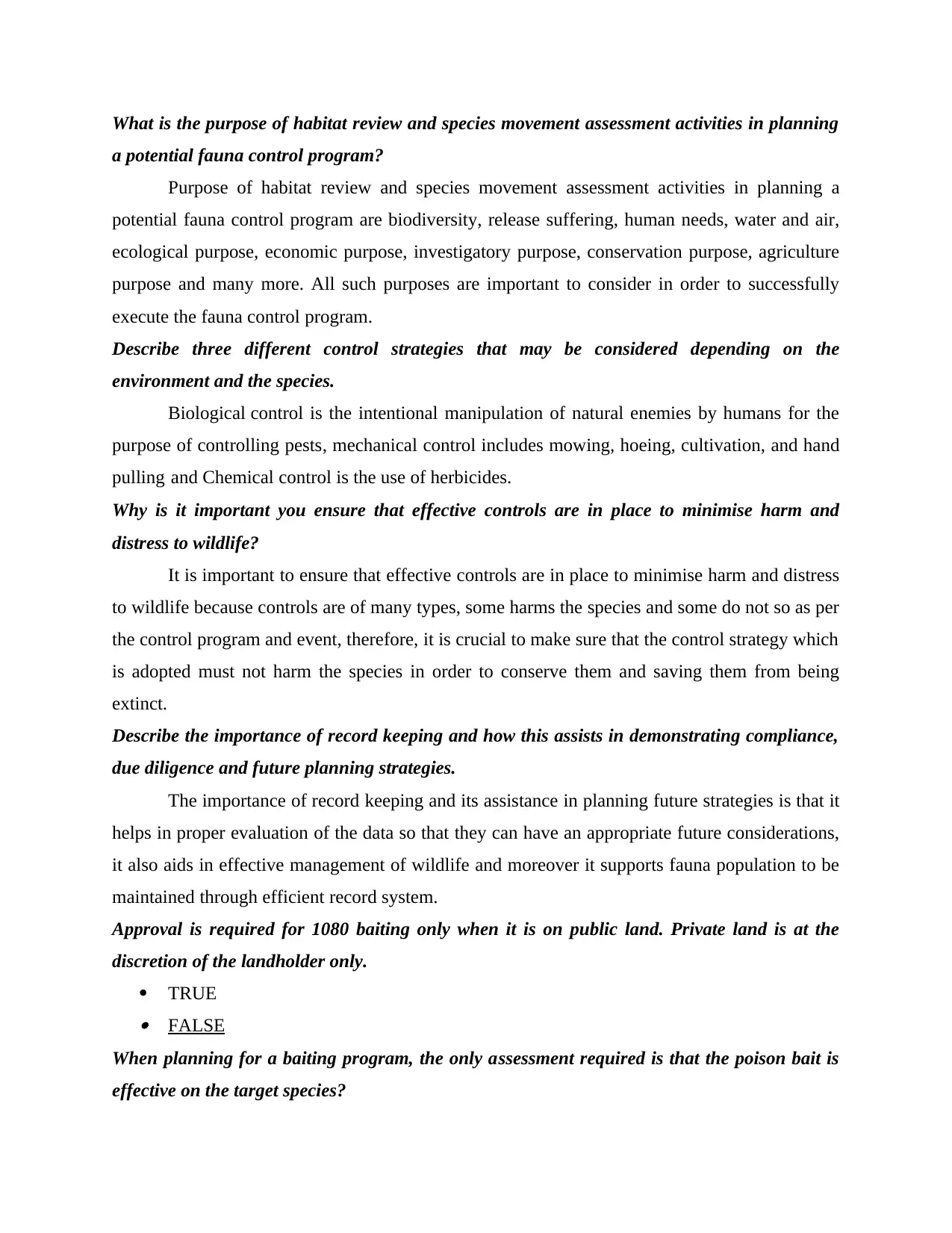
What is the purpose of habitat review and species movement assessment activities in planning
a potential fauna control program?
Purpose of habitat review and species movement assessment activities in planning a
potential fauna control program are biodiversity, release suffering, human needs, water and air,
ecological purpose, economic purpose, investigatory purpose, conservation purpose, agriculture
purpose and many more. All such purposes are important to consider in order to successfully
execute the fauna control program.
Describe three different control strategies that may be considered depending on the
environment and the species.
Biological control is the intentional manipulation of natural enemies by humans for the
purpose of controlling pests, mechanical control includes mowing, hoeing, cultivation, and hand
pulling and Chemical control is the use of herbicides.
Why is it important you ensure that effective controls are in place to minimise harm and
distress to wildlife?
It is important to ensure that effective controls are in place to minimise harm and distress
to wildlife because controls are of many types, some harms the species and some do not so as per
the control program and event, therefore, it is crucial to make sure that the control strategy which
is adopted must not harm the species in order to conserve them and saving them from being
extinct.
Describe the importance of record keeping and how this assists in demonstrating compliance,
due diligence and future planning strategies.
The importance of record keeping and its assistance in planning future strategies is that it
helps in proper evaluation of the data so that they can have an appropriate future considerations,
it also aids in effective management of wildlife and moreover it supports fauna population to be
maintained through efficient record system.
Approval is required for 1080 baiting only when it is on public land. Private land is at the
discretion of the landholder only.
TRUE FALSE
When planning for a baiting program, the only assessment required is that the poison bait is
effective on the target species?
a potential fauna control program?
Purpose of habitat review and species movement assessment activities in planning a
potential fauna control program are biodiversity, release suffering, human needs, water and air,
ecological purpose, economic purpose, investigatory purpose, conservation purpose, agriculture
purpose and many more. All such purposes are important to consider in order to successfully
execute the fauna control program.
Describe three different control strategies that may be considered depending on the
environment and the species.
Biological control is the intentional manipulation of natural enemies by humans for the
purpose of controlling pests, mechanical control includes mowing, hoeing, cultivation, and hand
pulling and Chemical control is the use of herbicides.
Why is it important you ensure that effective controls are in place to minimise harm and
distress to wildlife?
It is important to ensure that effective controls are in place to minimise harm and distress
to wildlife because controls are of many types, some harms the species and some do not so as per
the control program and event, therefore, it is crucial to make sure that the control strategy which
is adopted must not harm the species in order to conserve them and saving them from being
extinct.
Describe the importance of record keeping and how this assists in demonstrating compliance,
due diligence and future planning strategies.
The importance of record keeping and its assistance in planning future strategies is that it
helps in proper evaluation of the data so that they can have an appropriate future considerations,
it also aids in effective management of wildlife and moreover it supports fauna population to be
maintained through efficient record system.
Approval is required for 1080 baiting only when it is on public land. Private land is at the
discretion of the landholder only.
TRUE FALSE
When planning for a baiting program, the only assessment required is that the poison bait is
effective on the target species?
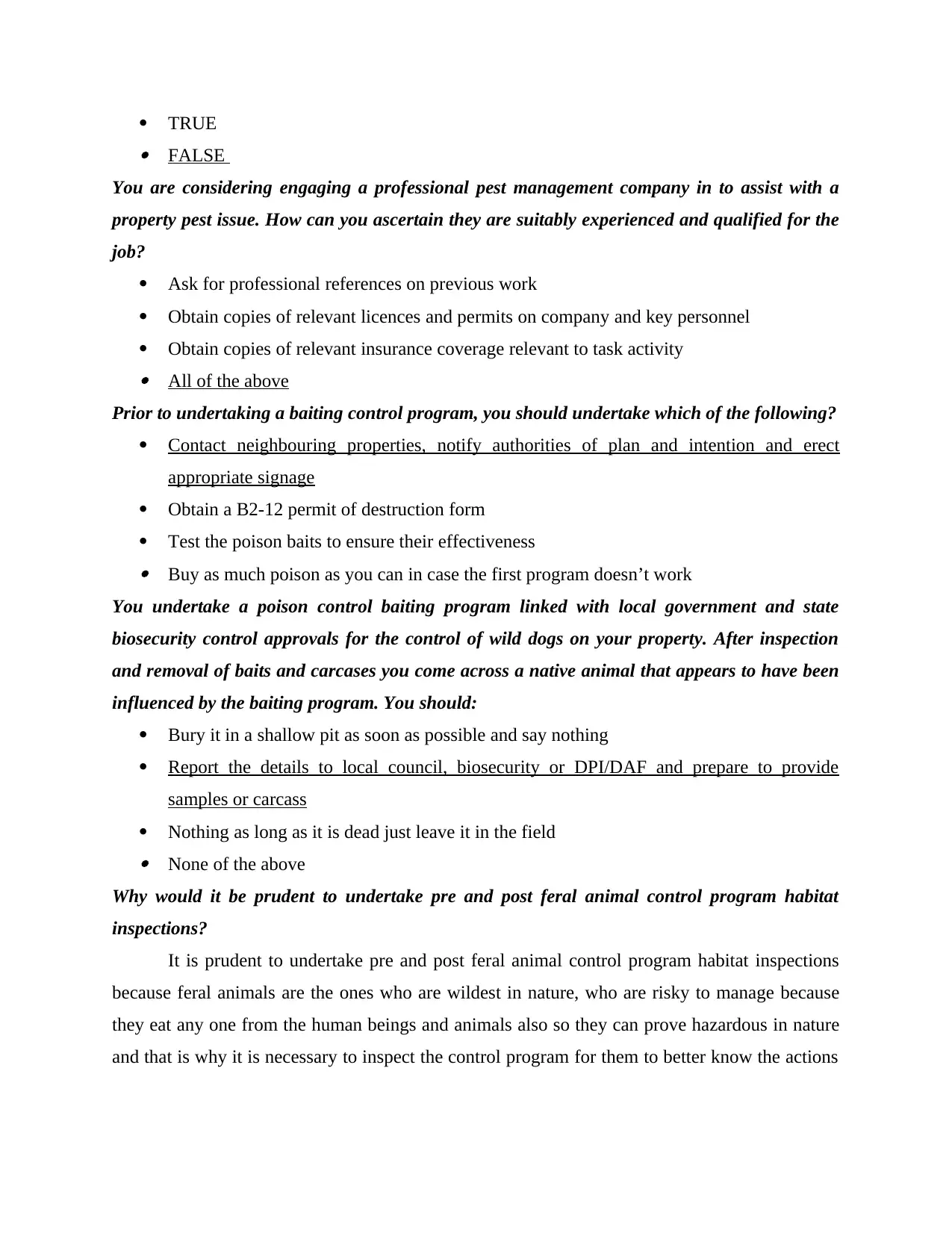
TRUE FALSE
You are considering engaging a professional pest management company in to assist with a
property pest issue. How can you ascertain they are suitably experienced and qualified for the
job?
Ask for professional references on previous work
Obtain copies of relevant licences and permits on company and key personnel
Obtain copies of relevant insurance coverage relevant to task activity All of the above
Prior to undertaking a baiting control program, you should undertake which of the following?
Contact neighbouring properties, notify authorities of plan and intention and erect
appropriate signage
Obtain a B2-12 permit of destruction form
Test the poison baits to ensure their effectiveness Buy as much poison as you can in case the first program doesn’t work
You undertake a poison control baiting program linked with local government and state
biosecurity control approvals for the control of wild dogs on your property. After inspection
and removal of baits and carcases you come across a native animal that appears to have been
influenced by the baiting program. You should:
Bury it in a shallow pit as soon as possible and say nothing
Report the details to local council, biosecurity or DPI/DAF and prepare to provide
samples or carcass
Nothing as long as it is dead just leave it in the field None of the above
Why would it be prudent to undertake pre and post feral animal control program habitat
inspections?
It is prudent to undertake pre and post feral animal control program habitat inspections
because feral animals are the ones who are wildest in nature, who are risky to manage because
they eat any one from the human beings and animals also so they can prove hazardous in nature
and that is why it is necessary to inspect the control program for them to better know the actions
You are considering engaging a professional pest management company in to assist with a
property pest issue. How can you ascertain they are suitably experienced and qualified for the
job?
Ask for professional references on previous work
Obtain copies of relevant licences and permits on company and key personnel
Obtain copies of relevant insurance coverage relevant to task activity All of the above
Prior to undertaking a baiting control program, you should undertake which of the following?
Contact neighbouring properties, notify authorities of plan and intention and erect
appropriate signage
Obtain a B2-12 permit of destruction form
Test the poison baits to ensure their effectiveness Buy as much poison as you can in case the first program doesn’t work
You undertake a poison control baiting program linked with local government and state
biosecurity control approvals for the control of wild dogs on your property. After inspection
and removal of baits and carcases you come across a native animal that appears to have been
influenced by the baiting program. You should:
Bury it in a shallow pit as soon as possible and say nothing
Report the details to local council, biosecurity or DPI/DAF and prepare to provide
samples or carcass
Nothing as long as it is dead just leave it in the field None of the above
Why would it be prudent to undertake pre and post feral animal control program habitat
inspections?
It is prudent to undertake pre and post feral animal control program habitat inspections
because feral animals are the ones who are wildest in nature, who are risky to manage because
they eat any one from the human beings and animals also so they can prove hazardous in nature
and that is why it is necessary to inspect the control program for them to better know the actions
⊘ This is a preview!⊘
Do you want full access?
Subscribe today to unlock all pages.

Trusted by 1+ million students worldwide
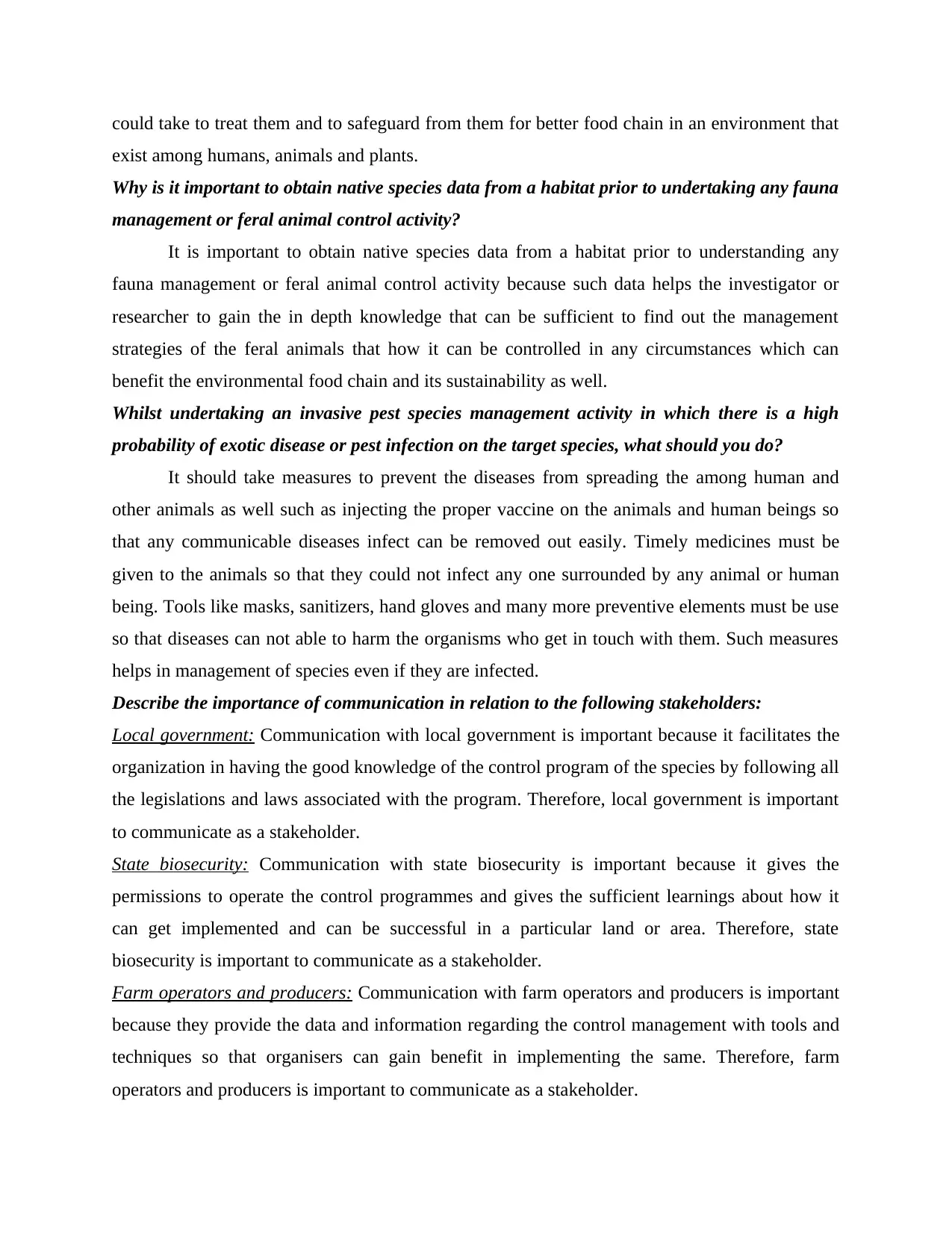
could take to treat them and to safeguard from them for better food chain in an environment that
exist among humans, animals and plants.
Why is it important to obtain native species data from a habitat prior to undertaking any fauna
management or feral animal control activity?
It is important to obtain native species data from a habitat prior to understanding any
fauna management or feral animal control activity because such data helps the investigator or
researcher to gain the in depth knowledge that can be sufficient to find out the management
strategies of the feral animals that how it can be controlled in any circumstances which can
benefit the environmental food chain and its sustainability as well.
Whilst undertaking an invasive pest species management activity in which there is a high
probability of exotic disease or pest infection on the target species, what should you do?
It should take measures to prevent the diseases from spreading the among human and
other animals as well such as injecting the proper vaccine on the animals and human beings so
that any communicable diseases infect can be removed out easily. Timely medicines must be
given to the animals so that they could not infect any one surrounded by any animal or human
being. Tools like masks, sanitizers, hand gloves and many more preventive elements must be use
so that diseases can not able to harm the organisms who get in touch with them. Such measures
helps in management of species even if they are infected.
Describe the importance of communication in relation to the following stakeholders:
Local government: Communication with local government is important because it facilitates the
organization in having the good knowledge of the control program of the species by following all
the legislations and laws associated with the program. Therefore, local government is important
to communicate as a stakeholder.
State biosecurity: Communication with state biosecurity is important because it gives the
permissions to operate the control programmes and gives the sufficient learnings about how it
can get implemented and can be successful in a particular land or area. Therefore, state
biosecurity is important to communicate as a stakeholder.
Farm operators and producers: Communication with farm operators and producers is important
because they provide the data and information regarding the control management with tools and
techniques so that organisers can gain benefit in implementing the same. Therefore, farm
operators and producers is important to communicate as a stakeholder.
exist among humans, animals and plants.
Why is it important to obtain native species data from a habitat prior to undertaking any fauna
management or feral animal control activity?
It is important to obtain native species data from a habitat prior to understanding any
fauna management or feral animal control activity because such data helps the investigator or
researcher to gain the in depth knowledge that can be sufficient to find out the management
strategies of the feral animals that how it can be controlled in any circumstances which can
benefit the environmental food chain and its sustainability as well.
Whilst undertaking an invasive pest species management activity in which there is a high
probability of exotic disease or pest infection on the target species, what should you do?
It should take measures to prevent the diseases from spreading the among human and
other animals as well such as injecting the proper vaccine on the animals and human beings so
that any communicable diseases infect can be removed out easily. Timely medicines must be
given to the animals so that they could not infect any one surrounded by any animal or human
being. Tools like masks, sanitizers, hand gloves and many more preventive elements must be use
so that diseases can not able to harm the organisms who get in touch with them. Such measures
helps in management of species even if they are infected.
Describe the importance of communication in relation to the following stakeholders:
Local government: Communication with local government is important because it facilitates the
organization in having the good knowledge of the control program of the species by following all
the legislations and laws associated with the program. Therefore, local government is important
to communicate as a stakeholder.
State biosecurity: Communication with state biosecurity is important because it gives the
permissions to operate the control programmes and gives the sufficient learnings about how it
can get implemented and can be successful in a particular land or area. Therefore, state
biosecurity is important to communicate as a stakeholder.
Farm operators and producers: Communication with farm operators and producers is important
because they provide the data and information regarding the control management with tools and
techniques so that organisers can gain benefit in implementing the same. Therefore, farm
operators and producers is important to communicate as a stakeholder.
Paraphrase This Document
Need a fresh take? Get an instant paraphrase of this document with our AI Paraphraser
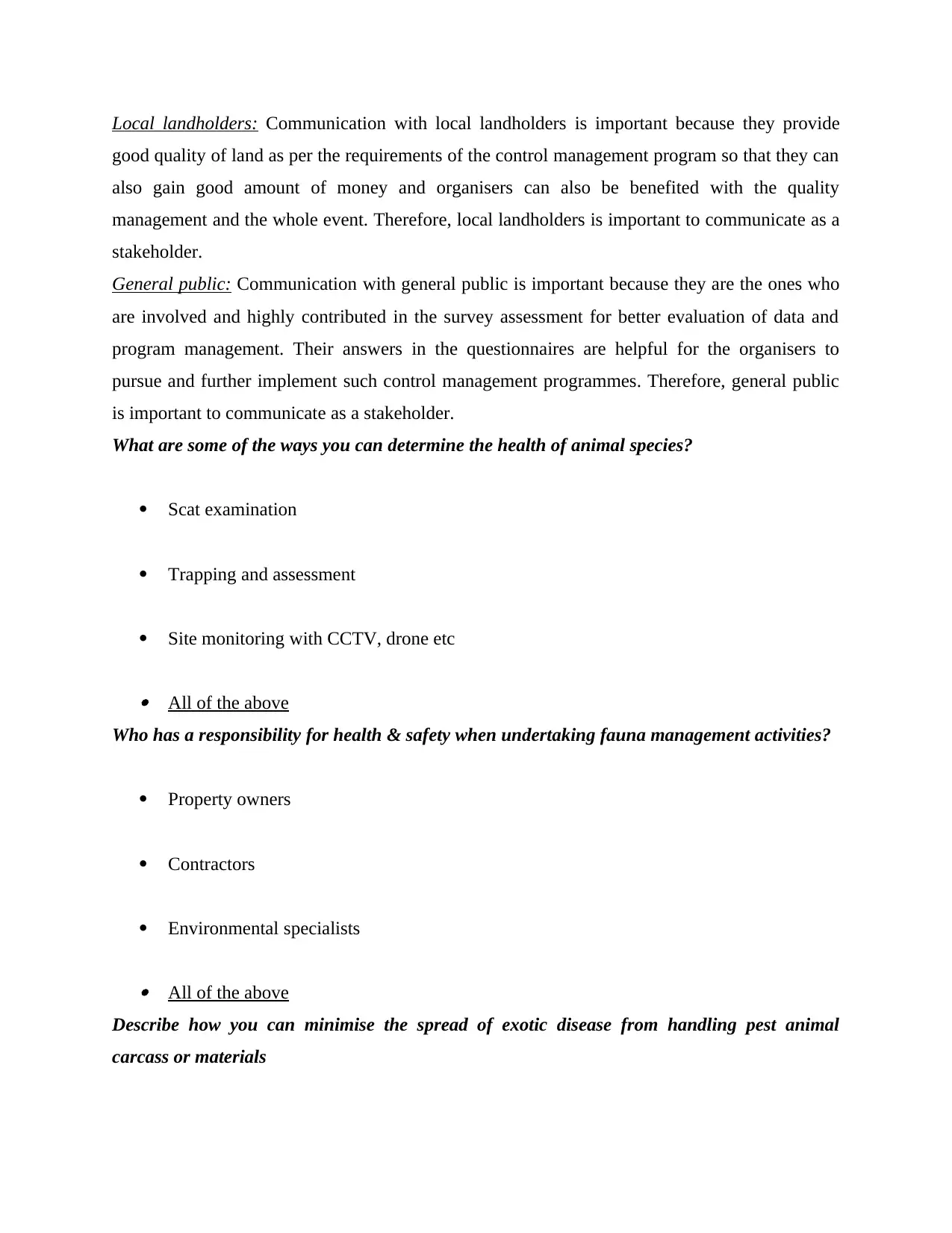
Local landholders: Communication with local landholders is important because they provide
good quality of land as per the requirements of the control management program so that they can
also gain good amount of money and organisers can also be benefited with the quality
management and the whole event. Therefore, local landholders is important to communicate as a
stakeholder.
General public: Communication with general public is important because they are the ones who
are involved and highly contributed in the survey assessment for better evaluation of data and
program management. Their answers in the questionnaires are helpful for the organisers to
pursue and further implement such control management programmes. Therefore, general public
is important to communicate as a stakeholder.
What are some of the ways you can determine the health of animal species?
Scat examination
Trapping and assessment
Site monitoring with CCTV, drone etc
All of the above
Who has a responsibility for health & safety when undertaking fauna management activities?
Property owners
Contractors
Environmental specialists
All of the above
Describe how you can minimise the spread of exotic disease from handling pest animal
carcass or materials
good quality of land as per the requirements of the control management program so that they can
also gain good amount of money and organisers can also be benefited with the quality
management and the whole event. Therefore, local landholders is important to communicate as a
stakeholder.
General public: Communication with general public is important because they are the ones who
are involved and highly contributed in the survey assessment for better evaluation of data and
program management. Their answers in the questionnaires are helpful for the organisers to
pursue and further implement such control management programmes. Therefore, general public
is important to communicate as a stakeholder.
What are some of the ways you can determine the health of animal species?
Scat examination
Trapping and assessment
Site monitoring with CCTV, drone etc
All of the above
Who has a responsibility for health & safety when undertaking fauna management activities?
Property owners
Contractors
Environmental specialists
All of the above
Describe how you can minimise the spread of exotic disease from handling pest animal
carcass or materials
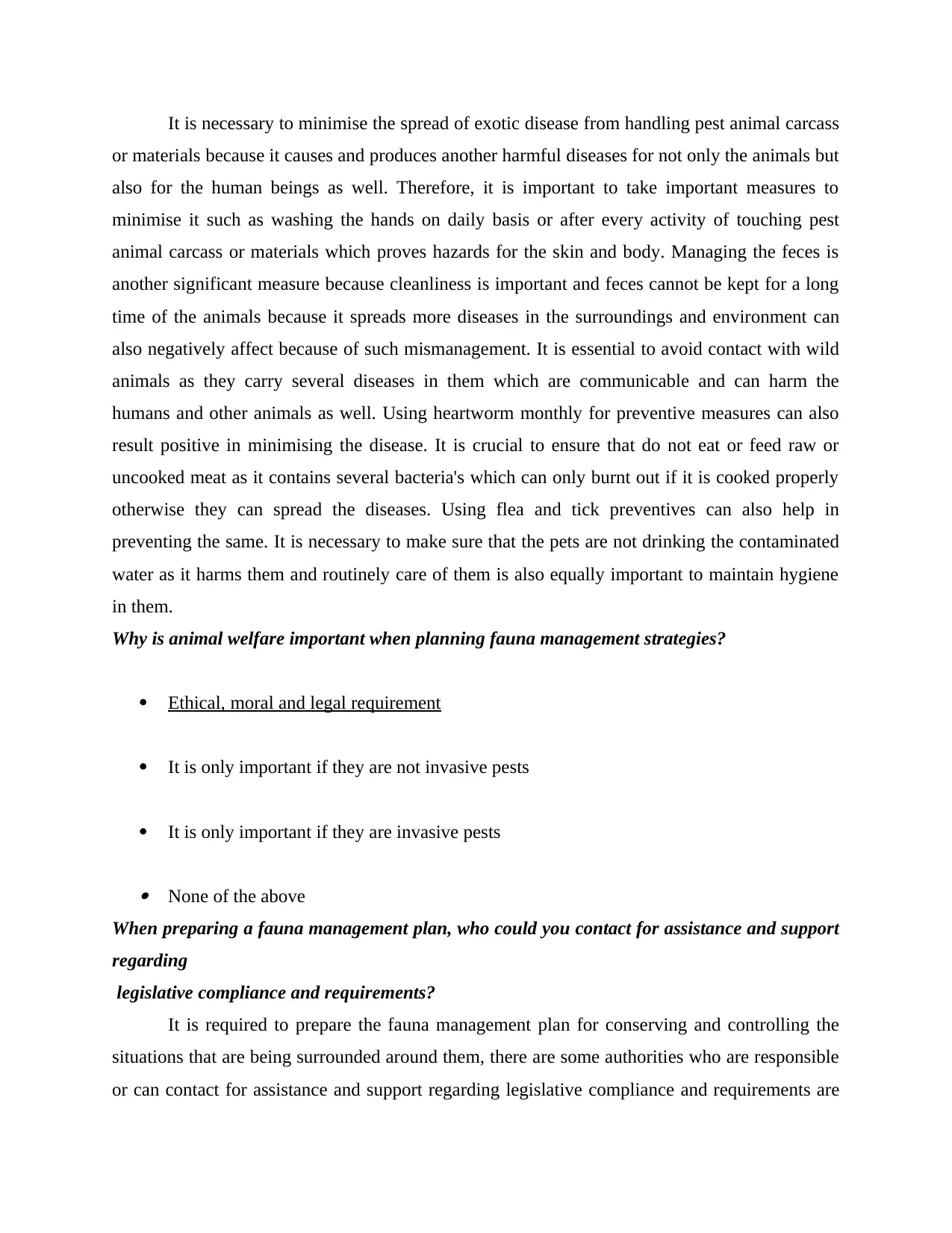
It is necessary to minimise the spread of exotic disease from handling pest animal carcass
or materials because it causes and produces another harmful diseases for not only the animals but
also for the human beings as well. Therefore, it is important to take important measures to
minimise it such as washing the hands on daily basis or after every activity of touching pest
animal carcass or materials which proves hazards for the skin and body. Managing the feces is
another significant measure because cleanliness is important and feces cannot be kept for a long
time of the animals because it spreads more diseases in the surroundings and environment can
also negatively affect because of such mismanagement. It is essential to avoid contact with wild
animals as they carry several diseases in them which are communicable and can harm the
humans and other animals as well. Using heartworm monthly for preventive measures can also
result positive in minimising the disease. It is crucial to ensure that do not eat or feed raw or
uncooked meat as it contains several bacteria's which can only burnt out if it is cooked properly
otherwise they can spread the diseases. Using flea and tick preventives can also help in
preventing the same. It is necessary to make sure that the pets are not drinking the contaminated
water as it harms them and routinely care of them is also equally important to maintain hygiene
in them.
Why is animal welfare important when planning fauna management strategies?
Ethical, moral and legal requirement
It is only important if they are not invasive pests
It is only important if they are invasive pests
None of the above
When preparing a fauna management plan, who could you contact for assistance and support
regarding
legislative compliance and requirements?
It is required to prepare the fauna management plan for conserving and controlling the
situations that are being surrounded around them, there are some authorities who are responsible
or can contact for assistance and support regarding legislative compliance and requirements are
or materials because it causes and produces another harmful diseases for not only the animals but
also for the human beings as well. Therefore, it is important to take important measures to
minimise it such as washing the hands on daily basis or after every activity of touching pest
animal carcass or materials which proves hazards for the skin and body. Managing the feces is
another significant measure because cleanliness is important and feces cannot be kept for a long
time of the animals because it spreads more diseases in the surroundings and environment can
also negatively affect because of such mismanagement. It is essential to avoid contact with wild
animals as they carry several diseases in them which are communicable and can harm the
humans and other animals as well. Using heartworm monthly for preventive measures can also
result positive in minimising the disease. It is crucial to ensure that do not eat or feed raw or
uncooked meat as it contains several bacteria's which can only burnt out if it is cooked properly
otherwise they can spread the diseases. Using flea and tick preventives can also help in
preventing the same. It is necessary to make sure that the pets are not drinking the contaminated
water as it harms them and routinely care of them is also equally important to maintain hygiene
in them.
Why is animal welfare important when planning fauna management strategies?
Ethical, moral and legal requirement
It is only important if they are not invasive pests
It is only important if they are invasive pests
None of the above
When preparing a fauna management plan, who could you contact for assistance and support
regarding
legislative compliance and requirements?
It is required to prepare the fauna management plan for conserving and controlling the
situations that are being surrounded around them, there are some authorities who are responsible
or can contact for assistance and support regarding legislative compliance and requirements are
⊘ This is a preview!⊘
Do you want full access?
Subscribe today to unlock all pages.

Trusted by 1+ million students worldwide
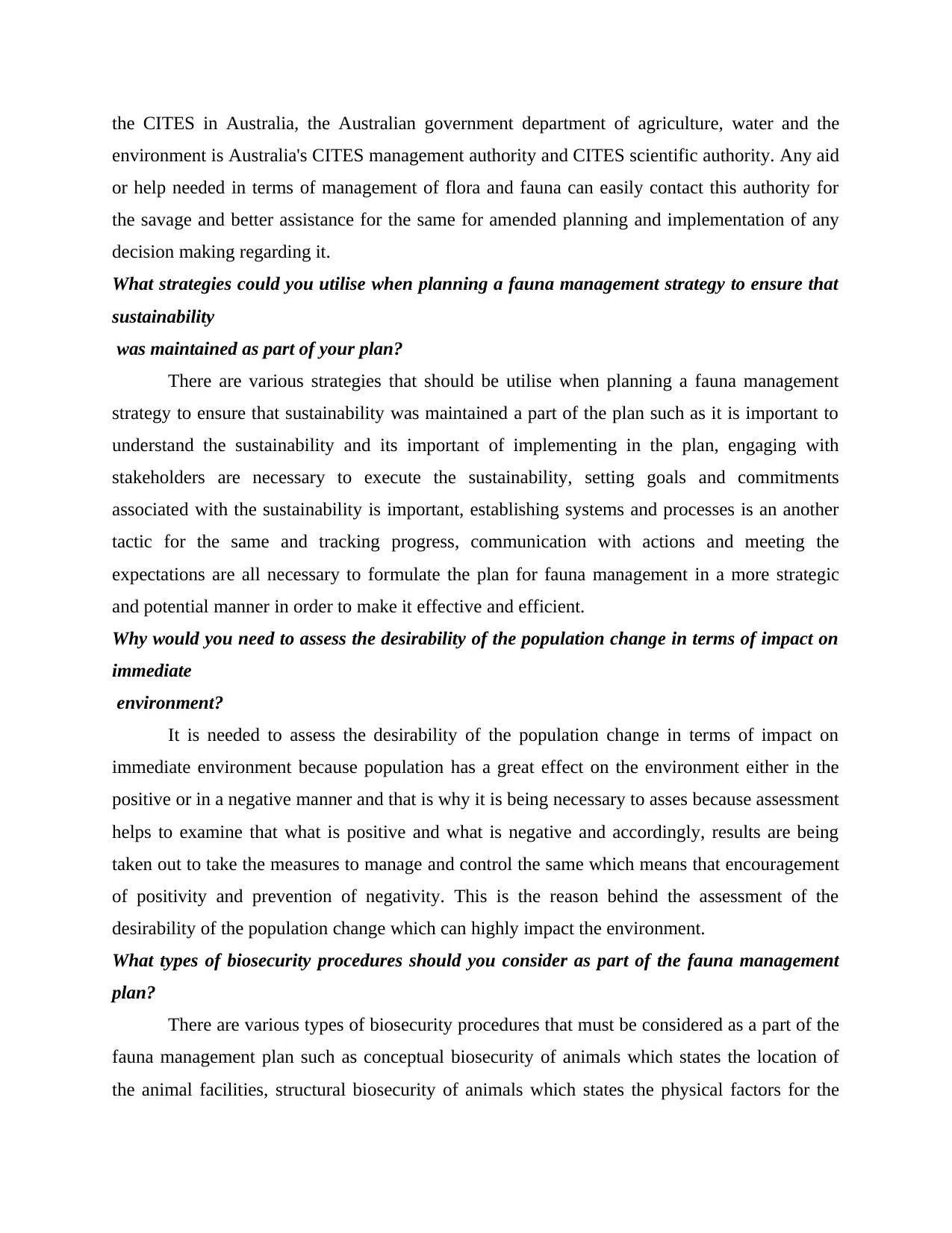
the CITES in Australia, the Australian government department of agriculture, water and the
environment is Australia's CITES management authority and CITES scientific authority. Any aid
or help needed in terms of management of flora and fauna can easily contact this authority for
the savage and better assistance for the same for amended planning and implementation of any
decision making regarding it.
What strategies could you utilise when planning a fauna management strategy to ensure that
sustainability
was maintained as part of your plan?
There are various strategies that should be utilise when planning a fauna management
strategy to ensure that sustainability was maintained a part of the plan such as it is important to
understand the sustainability and its important of implementing in the plan, engaging with
stakeholders are necessary to execute the sustainability, setting goals and commitments
associated with the sustainability is important, establishing systems and processes is an another
tactic for the same and tracking progress, communication with actions and meeting the
expectations are all necessary to formulate the plan for fauna management in a more strategic
and potential manner in order to make it effective and efficient.
Why would you need to assess the desirability of the population change in terms of impact on
immediate
environment?
It is needed to assess the desirability of the population change in terms of impact on
immediate environment because population has a great effect on the environment either in the
positive or in a negative manner and that is why it is being necessary to asses because assessment
helps to examine that what is positive and what is negative and accordingly, results are being
taken out to take the measures to manage and control the same which means that encouragement
of positivity and prevention of negativity. This is the reason behind the assessment of the
desirability of the population change which can highly impact the environment.
What types of biosecurity procedures should you consider as part of the fauna management
plan?
There are various types of biosecurity procedures that must be considered as a part of the
fauna management plan such as conceptual biosecurity of animals which states the location of
the animal facilities, structural biosecurity of animals which states the physical factors for the
environment is Australia's CITES management authority and CITES scientific authority. Any aid
or help needed in terms of management of flora and fauna can easily contact this authority for
the savage and better assistance for the same for amended planning and implementation of any
decision making regarding it.
What strategies could you utilise when planning a fauna management strategy to ensure that
sustainability
was maintained as part of your plan?
There are various strategies that should be utilise when planning a fauna management
strategy to ensure that sustainability was maintained a part of the plan such as it is important to
understand the sustainability and its important of implementing in the plan, engaging with
stakeholders are necessary to execute the sustainability, setting goals and commitments
associated with the sustainability is important, establishing systems and processes is an another
tactic for the same and tracking progress, communication with actions and meeting the
expectations are all necessary to formulate the plan for fauna management in a more strategic
and potential manner in order to make it effective and efficient.
Why would you need to assess the desirability of the population change in terms of impact on
immediate
environment?
It is needed to assess the desirability of the population change in terms of impact on
immediate environment because population has a great effect on the environment either in the
positive or in a negative manner and that is why it is being necessary to asses because assessment
helps to examine that what is positive and what is negative and accordingly, results are being
taken out to take the measures to manage and control the same which means that encouragement
of positivity and prevention of negativity. This is the reason behind the assessment of the
desirability of the population change which can highly impact the environment.
What types of biosecurity procedures should you consider as part of the fauna management
plan?
There are various types of biosecurity procedures that must be considered as a part of the
fauna management plan such as conceptual biosecurity of animals which states the location of
the animal facilities, structural biosecurity of animals which states the physical factors for the
Paraphrase This Document
Need a fresh take? Get an instant paraphrase of this document with our AI Paraphraser
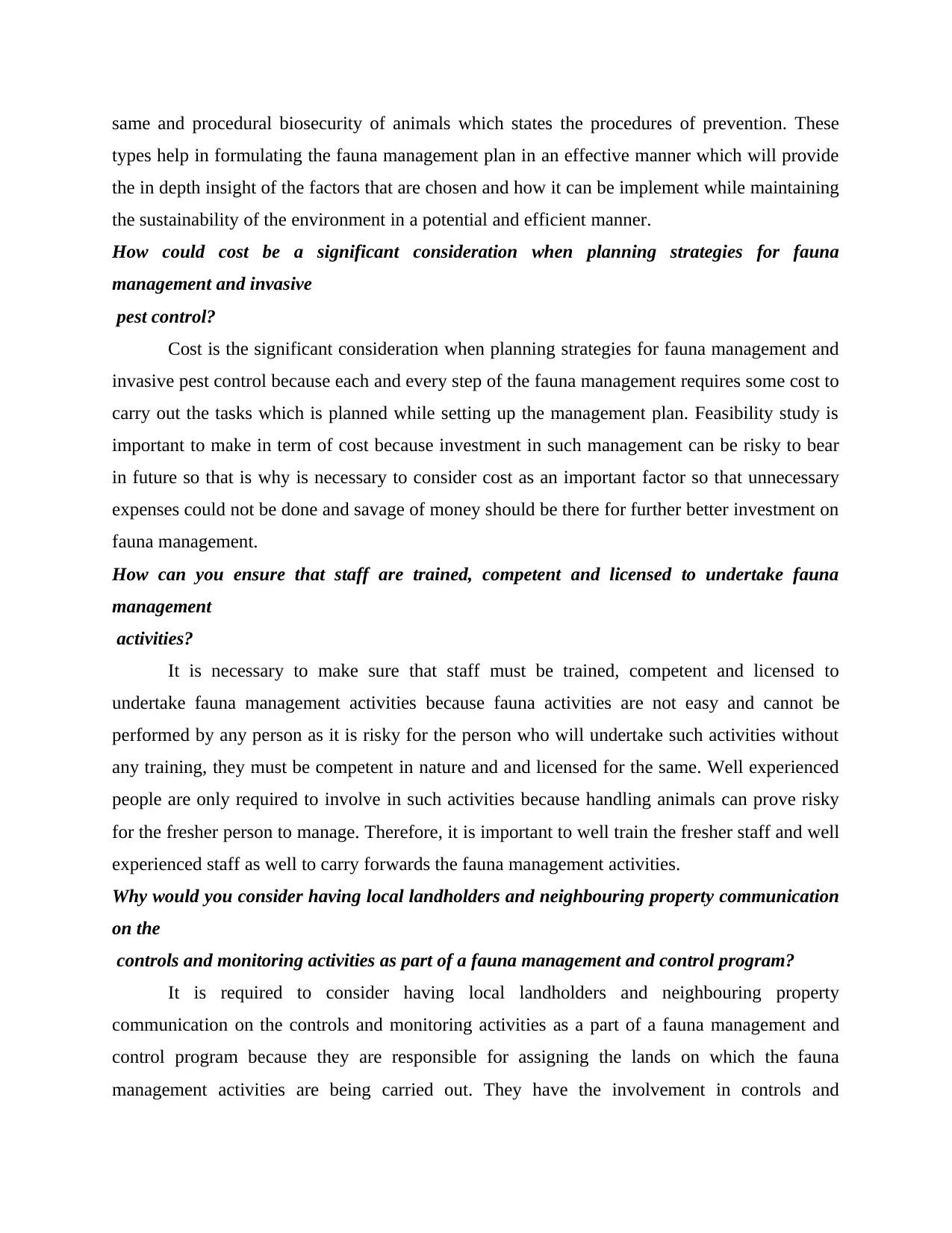
same and procedural biosecurity of animals which states the procedures of prevention. These
types help in formulating the fauna management plan in an effective manner which will provide
the in depth insight of the factors that are chosen and how it can be implement while maintaining
the sustainability of the environment in a potential and efficient manner.
How could cost be a significant consideration when planning strategies for fauna
management and invasive
pest control?
Cost is the significant consideration when planning strategies for fauna management and
invasive pest control because each and every step of the fauna management requires some cost to
carry out the tasks which is planned while setting up the management plan. Feasibility study is
important to make in term of cost because investment in such management can be risky to bear
in future so that is why is necessary to consider cost as an important factor so that unnecessary
expenses could not be done and savage of money should be there for further better investment on
fauna management.
How can you ensure that staff are trained, competent and licensed to undertake fauna
management
activities?
It is necessary to make sure that staff must be trained, competent and licensed to
undertake fauna management activities because fauna activities are not easy and cannot be
performed by any person as it is risky for the person who will undertake such activities without
any training, they must be competent in nature and and licensed for the same. Well experienced
people are only required to involve in such activities because handling animals can prove risky
for the fresher person to manage. Therefore, it is important to well train the fresher staff and well
experienced staff as well to carry forwards the fauna management activities.
Why would you consider having local landholders and neighbouring property communication
on the
controls and monitoring activities as part of a fauna management and control program?
It is required to consider having local landholders and neighbouring property
communication on the controls and monitoring activities as a part of a fauna management and
control program because they are responsible for assigning the lands on which the fauna
management activities are being carried out. They have the involvement in controls and
types help in formulating the fauna management plan in an effective manner which will provide
the in depth insight of the factors that are chosen and how it can be implement while maintaining
the sustainability of the environment in a potential and efficient manner.
How could cost be a significant consideration when planning strategies for fauna
management and invasive
pest control?
Cost is the significant consideration when planning strategies for fauna management and
invasive pest control because each and every step of the fauna management requires some cost to
carry out the tasks which is planned while setting up the management plan. Feasibility study is
important to make in term of cost because investment in such management can be risky to bear
in future so that is why is necessary to consider cost as an important factor so that unnecessary
expenses could not be done and savage of money should be there for further better investment on
fauna management.
How can you ensure that staff are trained, competent and licensed to undertake fauna
management
activities?
It is necessary to make sure that staff must be trained, competent and licensed to
undertake fauna management activities because fauna activities are not easy and cannot be
performed by any person as it is risky for the person who will undertake such activities without
any training, they must be competent in nature and and licensed for the same. Well experienced
people are only required to involve in such activities because handling animals can prove risky
for the fresher person to manage. Therefore, it is important to well train the fresher staff and well
experienced staff as well to carry forwards the fauna management activities.
Why would you consider having local landholders and neighbouring property communication
on the
controls and monitoring activities as part of a fauna management and control program?
It is required to consider having local landholders and neighbouring property
communication on the controls and monitoring activities as a part of a fauna management and
control program because they are responsible for assigning the lands on which the fauna
management activities are being carried out. They have the involvement in controls and
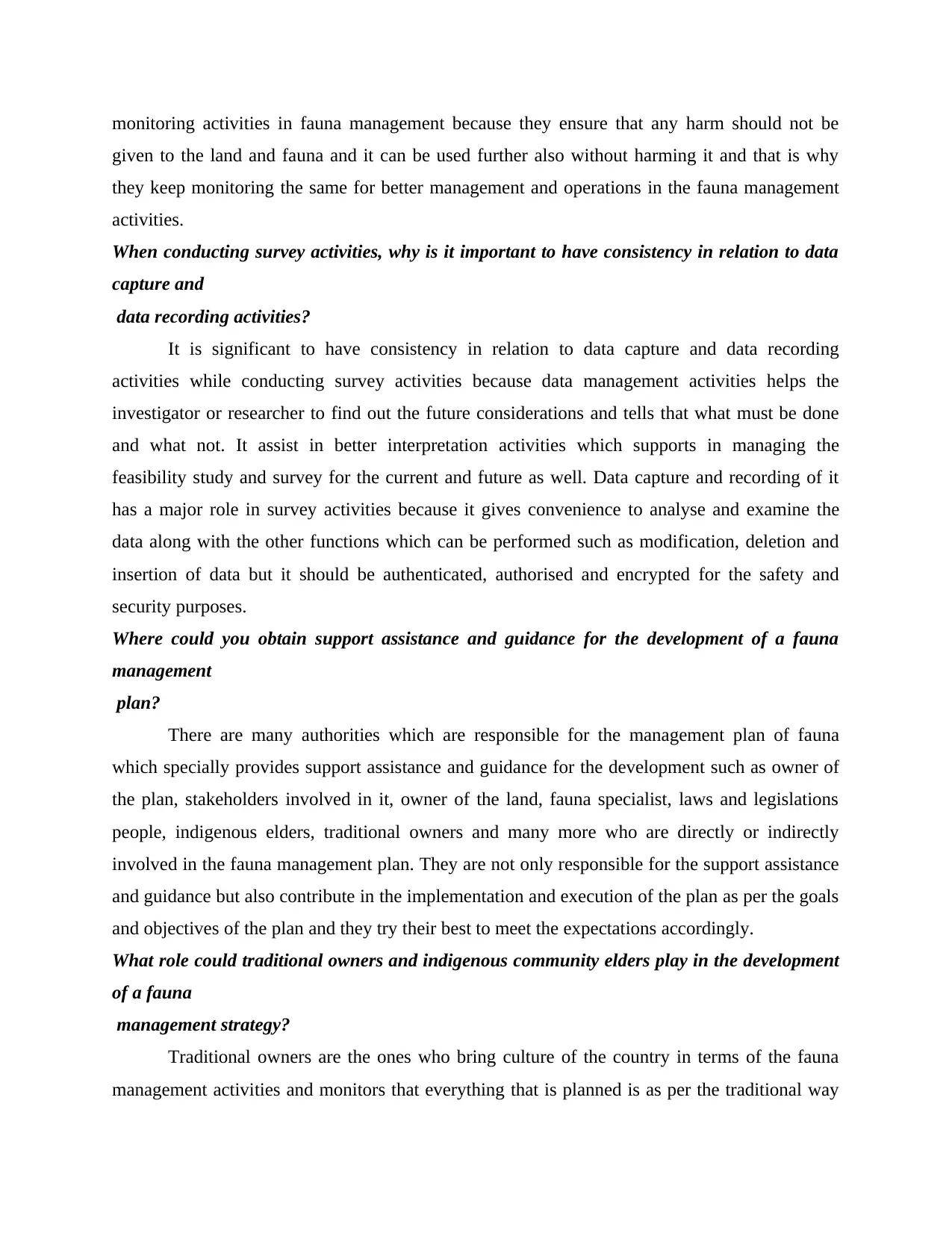
monitoring activities in fauna management because they ensure that any harm should not be
given to the land and fauna and it can be used further also without harming it and that is why
they keep monitoring the same for better management and operations in the fauna management
activities.
When conducting survey activities, why is it important to have consistency in relation to data
capture and
data recording activities?
It is significant to have consistency in relation to data capture and data recording
activities while conducting survey activities because data management activities helps the
investigator or researcher to find out the future considerations and tells that what must be done
and what not. It assist in better interpretation activities which supports in managing the
feasibility study and survey for the current and future as well. Data capture and recording of it
has a major role in survey activities because it gives convenience to analyse and examine the
data along with the other functions which can be performed such as modification, deletion and
insertion of data but it should be authenticated, authorised and encrypted for the safety and
security purposes.
Where could you obtain support assistance and guidance for the development of a fauna
management
plan?
There are many authorities which are responsible for the management plan of fauna
which specially provides support assistance and guidance for the development such as owner of
the plan, stakeholders involved in it, owner of the land, fauna specialist, laws and legislations
people, indigenous elders, traditional owners and many more who are directly or indirectly
involved in the fauna management plan. They are not only responsible for the support assistance
and guidance but also contribute in the implementation and execution of the plan as per the goals
and objectives of the plan and they try their best to meet the expectations accordingly.
What role could traditional owners and indigenous community elders play in the development
of a fauna
management strategy?
Traditional owners are the ones who bring culture of the country in terms of the fauna
management activities and monitors that everything that is planned is as per the traditional way
given to the land and fauna and it can be used further also without harming it and that is why
they keep monitoring the same for better management and operations in the fauna management
activities.
When conducting survey activities, why is it important to have consistency in relation to data
capture and
data recording activities?
It is significant to have consistency in relation to data capture and data recording
activities while conducting survey activities because data management activities helps the
investigator or researcher to find out the future considerations and tells that what must be done
and what not. It assist in better interpretation activities which supports in managing the
feasibility study and survey for the current and future as well. Data capture and recording of it
has a major role in survey activities because it gives convenience to analyse and examine the
data along with the other functions which can be performed such as modification, deletion and
insertion of data but it should be authenticated, authorised and encrypted for the safety and
security purposes.
Where could you obtain support assistance and guidance for the development of a fauna
management
plan?
There are many authorities which are responsible for the management plan of fauna
which specially provides support assistance and guidance for the development such as owner of
the plan, stakeholders involved in it, owner of the land, fauna specialist, laws and legislations
people, indigenous elders, traditional owners and many more who are directly or indirectly
involved in the fauna management plan. They are not only responsible for the support assistance
and guidance but also contribute in the implementation and execution of the plan as per the goals
and objectives of the plan and they try their best to meet the expectations accordingly.
What role could traditional owners and indigenous community elders play in the development
of a fauna
management strategy?
Traditional owners are the ones who bring culture of the country in terms of the fauna
management activities and monitors that everything that is planned is as per the traditional way
⊘ This is a preview!⊘
Do you want full access?
Subscribe today to unlock all pages.

Trusted by 1+ million students worldwide
1 out of 13